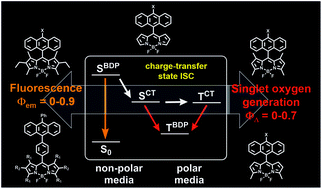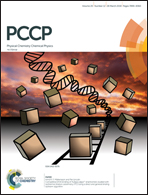Control of triplet state generation in heavy atom-free BODIPY–anthracene dyads by media polarity and structural factors†
Abstract
A family of heavy atom-free BODIPY–anthracene dyads (BADs) exhibiting triplet excited state formation from charge-transfer states is reported. Four types of BODIPY scaffolds, different in the alkyl substitution pattern, and four anthracene derivatives have been used to access BADs. Fluorescence and intersystem crossing (ISC) in these dyads depend on donor–acceptor couplings and can be accurately controlled by substitution or media polarity. Under conditions that do not allow charge transfer (CT), the dyads exhibit fluorescence with high quantum yields. Formation of charge-transfer states triggers ISC and the formation of long-lived triplet excited states in the dyads. The excited state properties were studied by steady-state techniques and ultrafast pump–probe spectroscopy to determine the parameters of the observed processes. Structural information for various BADs was derived from single crystal X-ray structure determinations alongside DFT molecular geometry optimization, revealing the effects of mutual orientation of subunits on the photophysical properties. The calculations showed that alkyl substituents on the BODIPY destabilize CT states in the dyads, thus controlling the charge transfer between the subunits. The effect of the dyad structure on the ISC efficiency was considered at the M06-2X level of theory, and a correlation between mutual orientation of the subunits and the energy gap between singlet and triplet CT states was studied using a multireference CASSCF method.

- This article is part of the themed collection: 2018 PCCP HOT Articles


 Please wait while we load your content...
Please wait while we load your content...